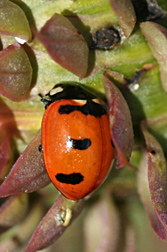This page has been archived and is being provided for reference purposes only. The page is no longer being updated, and therefore, links on the page may be invalid.
|
|
|
|
ARS Scientists and Cooperators Surveying for Rare Ladybugs
By Don ComisSeptember 18, 2008
Agricultural Research Service (ARS) scientists and cooperators are seeking the public's help in surveying for once-common ladybug species that are now hard to find.
Researchers with ARS, Cornell University at Ithaca, N.Y., and South Dakota State University (SDSU) in Brookings want people to photograph every ladybug possible, and to send the photos to Cornell so researchers can inventory the insects. In particular, the scientists are looking for rare species, such as the nine-spotted, two-spotted and transverse lady beetles.
These beetles were common 20 years ago, but have become harder to find in the past few decades. There are more than 400 ladybug species native to North America, but some have become extremely rare, displaced perhaps by development, pesticides, non-native species and other factors.
Entomologist Louis Hesler at the ARS North Central Agricultural Research Laboratory in Brookings is particularly interested in the nine-spotted, two-spotted and transverse ladybugs because the farm community in South Dakota where he works has depended on these predatory beetles for years to eat insect pests that eat farm crops.
Urban gardeners are interested in ladybugs because they protect garden crops as well. Ladybugs also protect North American forests.
In a survey this past summer, Hesler and colleague Mike Catangui, an entomologist at SDSU in Brookings, found 1,000 ladybugs, but only about 10 each of the three rare species. Hesler and Catangui are co-principal investigators in the SDSU part of the "Lost Ladybug Project."
The project has two facets: the research component, which Hesler, Catangui, and other scientists in New York State are participating in, and the citizen science component.
As part of the citizen science part of the project, researchers are encouraging participation from students who are interested in entomology, agriculture or science.
Those wishing to participate can visit http://www.lostladybug.org/ for tips on finding and photographing ladybugs and submitting photos. The website includes ways to track and map the Lost Ladybug data.
ARS is a scientific research agency within the U.S. Department of Agriculture.

